ARCHIVED - Office of the Information Commissioner of Canada
 This page has been archived.
This page has been archived.
Archived Content
Information identified as archived on the Web is for reference, research or recordkeeping purposes. It has not been altered or updated after the date of archiving. Web pages that are archived on the Web are not subject to the Government of Canada Web Standards. As per the Communications Policy of the Government of Canada, you can request alternate formats on the "Contact Us" page.
2007-08
Departmental Performance Report
Office of the Information Commissioner of Canada
The original version was signed by
The Honourable Robert Douglas Nicholson, PC. QC, M.P.
Minister of Justice
The Honourable Robert Marleau
Information Commissioner of Canada
Table of Contents
1.1 Message from the Information Commissioner of Canada
1.2 Management Representation Statement
1.3 Strategic Outcome and Program Activity Architecture (PAA)
1.5 Financial and Human Resources
1.7 Factors Affecting Performance in 2007-2008
Section II: Analysis by Program Activity
Section III: Supplementary Information
3.1 Link to the Government of Canada Outcomes
3.3 Sources of Additional Information
Section IV: Other Items of Interest
4.2 Reporting on the administration of the Access to Information Act
Section I: Overview
1.1 Message from the Information Commissioner of Canada
It is with great pleasure that I table before Parliament the Departmental Performance Report of the Office of the Information Commissioner of Canada (Office) for the fiscal year ending March 31, 2008.

My first full year in Office has been one of profound change, both in the world of access to information and in the workings of the Office, as well as one of considerable progress. I have sought to set the Office on a new course so it is better equipped to carry out its mandate of investigating complaints and to lay strong foundations to help us achieve our goal of excellence in serving Parliament and Canadians and advocating for openness in government.
On April 1, 2007 a number of new institutions became subject to the Access to Information Act, including the Office, as a result of the passage of the Federal Accountability Act. To meet our new obligations and challenges, we made major changes to the way the Office is structured, the processes we follow, and our complement of employees. We obtained additional funds to allow us to build this organizational capacity and develop our core functions. Among further improvements was the re-evaluation of the report cards process to establish a new approach that will produce a more balanced and comprehensive review of systemic issues.
In addition to delivering on our legal mandate the Office had four priorities as laid out in the 2007-2008 Report on Plans and Priorities:
- Reduce the backlog of investigations and ensure appropriate service standards are met, given increased demand resulting from the passage of the Federal Accountability Act;
- Reduce the number of complaints by engaging in departmental reviews (report cards), encouraging training of ATIP professionals, and raising awareness among federal institutions of their obligations under the Access to Information Act;
- Establish and administer a capacity to respond to requests under both the Access to Information Act and the Privacy Act, and comply with the administrative provisions of those statutes;
- Assist the government and Parliament in assessing proposals for reform of the Access to Information Act.
The Office achieved all but one of these priorities during the past year.
- Although we did not reduce the backlog of investigations, we established a new strategy and approach that will put us in a much stronger position to deliver on this priority in the coming year;
- Despite an increased number of complaints in 2007-2008, we have put continued efforts into improving the overall performance of federal institutions through a renewed report card process as well as contributing to an improved stewardship of the access to information program;
- We set up a secretariat and established new processes for handling access to information and privacy requests to meet our obligations under both Acts;
- We began work on legislative and administrative reforms towards modernizing the access to information regime and published a reference document to support these initiatives.
My principle goal is to ensure the access to information system functions in the best interests of Canadians. My first year was one of considerable progress in building our capacity to serve. I am confident that as we continue to develop the Office’s core functions we will see positive results in achieving all our objectives.
Robert Marleau
Information Commissioner of Canada
1.2 Management Representation Statement
I submit for tabling in Parliament, the 2007–2008 Departmental Performance Report for the Office of the Information Commissioner of Canada.
This document has been prepared based on the reporting principles contained in the Guide for the Preparation of Part III of the 2007–2008 Estimates: Reports on Plans and Priorities and Departmental Performance Reports:
- It adheres to the specific reporting requirements outlined in the Treasury Board Secretariat guidance;
- It is based on the institution’s Strategic Outcome and Program Activity Architecture;
- It presents consistent, comprehensive, balanced and reliable information;
- It provides a basis of accountability for the results achieved with the resources and authorities entrusted to it; and
- It reports finances based on approved numbers from the Estimates and the Public Accounts of Canada.
Suzanne Legault
Assistant Information Commissioner
Policy, Communications and Operations
1.3 Strategic Outcome and Program Activity Architecture (PAA)
The Office has a single strategic outcome and a single program activity as follows:
|
Strategic Outcome |
Individuals’ rights under the Access to Information Act are safeguarded. |
|
Program Activity 1 |
Compliance with access to information obligations |
The raison d’être of the Office is to ensure that the rights conferred by the Access to Information Act are respected; that complainants, heads of federal institutions and all third parties affected by complaints are given a reasonable opportunity to make representations to the Information Commissioner; to persuade federal institutions to adopt information practices consistent with the objectives of the Access to Information Act; and to bring appropriate issues of interpretation of the Access to Information Act before the Federal Court. The Office also advocates for greater access to information in Canada and promotes Canadians’ right to access government information.
1.5 Financial and Human Resources
The following two tables present the total financial and human resources that the Office has managed in 2007-2008.
|
Financial Resources ($000) |
||
|
Planned Spending |
Total Authorities |
Actual Spending |
|
$9,248 |
$8,091 |
$ 7,856 |
|
Human Resources (FTEs*) |
||
|
Planned |
Actual |
Difference |
|
90 |
60 |
30 |
The difference between the planned and actual human resources was caused by the delay in staffing positions due to a shortage of office space as well as planned resources that were not received. Funds related to the passage of the Federal Accountability Act and the establishment of the internal audit functions will be obtained during fiscal year 2008-2009.
1.6 Performance Status
The Office had four priorities for 2007-2008. The following table summarizes the actual performance of the Office against the priorities and includes a self-assessment of performance status. This table is a high-level presentation and more detailed information on actual performance is provided in Section II – Analysis by Program Activity.
|
Strategic Outcome: Individuals’ rights under the Access to Information Act are safeguarded. |
|||
|
Priorities for 2007-2008 |
Type |
Actual performance |
Performance Status |
|
1. Reduce the backlog of investigations and ensure appropriate service standards are met, given increased demand resulting from the passage of the
Federal Accountability Act. |
Previous |
We were unable to reduce the backlog of cases this year since we experienced an 81% increase in the number of complaints received. By year-end, 85% of our investigations were in backlog status according to our service standards. Nevertheless, we improved our average time to close the complaints going from 12.4 months last year to eight months this year, a 36% improvement rate. Moreover, we developed and started implementing an 11-point backlog strategy, including streamlining our complaints-handling process and planning a pilot project for a dedicated intake and early resolution unit. |
Not met |
| 2. Reduce the number of complaints by engaging in departmental reviews, encouraging training of ATIP professionals, and raising awareness of federal institutions’ responsibilities and obligations under the ATIA. |
Previous |
Although the Office experienced an increase in the number of complaints received primarily as a result of the coming into force of the Federal Accountability Act, we have continued to put efforts into improving overall performance of federal institutions against their obligations under the Access to Information Act. Ten report cards (departmental reviews) will be undertaken during the next fiscal year to evaluate the period of 2007-2008 based on a new and more balanced assessment. The Office and the Information Commissioner met with a large number of federal institutions, made presentations to Deputy Ministers to discuss the new "Duty to Assist" provision and made presentations before the ATIP community. We also began discussions with the Canadian School of Public Service and the Office of the Privacy Commissioner to develop a curriculum to train public servants in the field of access to information and privacy. We also continued to support the University of Alberta’s Information Access and Protection of Privacy Certificate Program by acting as a member of the program’s Advisory Committee and by enrolling staff in the program. |
Partially met1 |
|
3. Establish and administer a capacity to respond to requests under both the Access to Information Act and the
Privacy Act, and to comply with the administrative provisions of those statutes. |
New |
As of April 1, 2007, the OIC became subject to the Access to Information Act and the Privacy Act. We have set up an access to information and privacy secretariat to administer both Acts. The secretariat worked on a policy and procedures manual for the administration of access requests. It gave awareness training to employees on their responsibilities and requirements under both Acts. Further, to address the integrity of the complaints process, the Office established adequate safeguards to prevent possible conflict of interest if the Office were to investigate itself. The Commissioner appointed an ad hoc Information Commissioner to handle these complaints independently from the Office. |
Successfully met |
|
4. Assist the government and Parliament in assessing proposals for reform of the
Access to Information Act |
Previous |
During 2007–2008, we began work with the Department of Justice and the Treasury Board Secretariat on legislative and administrative initiatives about access to information. As part of the work on the legislative reform, we prepared a reference document that lists the proposals contained in the Open Government Act, draft bill with their sources. A copy of the document is available on our website. (www.infocom.gc.ca/publications/pdf_en/OGA_notes.pdf). |
Successfully met |
1.7 Factors Affecting Performance in 2007-2008
In 2007-2008, the following external and internal factors influenced how the Office delivered on its ombudsman’s functions as well as the relative priority of the activities carried out during the year.
External Factors
Federal Accountability Act
The impact of the Federal Accountability Act and the resulting amendments to the Access to Information Act and the Privacy Act has been substantial. During 2007–2008, about 70 institutions, including Crown corporations and their wholly owned subsidiaries, and various foundations and agencies became subject to the ATIA. This represents a 37 percent increase in the number of institutions covered by the Act, and brings the total to more than 250. Among that group of organizations was the Office of the Information Commissioner, which required us to set up an effective access to information and privacy program and to appoint an ad hoc Information Commissioner to respond to access to information complaints about us.
Another major implication of the increase in institutions subject to the Act is that we are managing a larger volume of complaints. As stated previously, the number of complaints increased in 2007-2008 by 81 percent over last year. The fact that the Federal Accountability Act reduced the time period in which requesters could complain to our Office from one year to 60 days also contributed to the number of complaints received during the year. Possible reasons for the increase in the number of complaints that are not specifically related to the Federal Accountability Act may be a renewed interest in the Act arising from the Gomery Commission, an increased number of consultations with other federal institutions and claims for longer extensions.
We provided assistance to the new institutions as they gained experience in administering the Act and the complaint process. We obtained additional funds from Treasury Board to allow us to meet the requirements of the Federal Accountability Act.
Systemic challenges
There are a number of challenges facing the entire access to information system that have direct impacts on the performance of the Office. One of the most significant challenges is a shortage of qualified workforce across the government, which was amplified by the passing of the Federal Accountability Act. Not only does this create a retention problem with our current
staff of investigators, it contributes to the difficulty to hire qualified workforce across government. With shortages and less experienced staff in federal institutions, as well as institutions placing the priority on requests and consultations, our investigation of complaints involving them may be delayed, thus having an impact on our ability to conduct investigations in a timely
way.
Internal Factors
According to the Office’s service standards, the backlog stood at 2,318 at the end of 2007-2008, a significant increase from the previous year. Although the Office closed more complaints this year by comparison to 2006-2007, at year-end, almost 85% of the cases were in backlog status. Despite considerable efforts to reduce this number, the Office received an unprecedented number of complaints which significantly contributed to the state of the backlog. The Office devised a backlog strategy to improve the effectiveness of the complaints-handling process and to ensure timely resolution.
Institutional changes
An important factor that contributed to the performance of the Office in 2007-2008 related to the limited capacity of the Office in terms of funding, staff levels, support tools as well as core administrative functions. We put considerable effort into building organizational capacity and developing our core functions in 2007-2008.
Section II: Analysis by Program Activity
2.1 Performance in 2007-2008
Program Activity 1: Compliance with access to information obligations
Program Activity Description
The Access to Information Act is the legislative authority for the oversight activities of the Information Commissioner, which are:
- to investigate complaints from individuals and corporations;
- to review the performance of government institutions;
- to report the results of investigations/reviews and recommendations to complainants, government institutions, and Parliament;
- to pursue judicial enforcement; and
- to provide advice to Parliament on access to information matters.
| Financial Resources ($000) | ||
| Planned Spending | Total Authorities | Actual Spending |
| $9,248 | $8,091 | $7,856 |
| Human Resources (FTEs) | ||
| Planned | Actual | Difference |
| 90 | 60 | 30 |
Performance in 2007-2008
Investigations:
- 1% of complaint investigations were completed within set service standards.
- 100% of well-founded complaints were resolved without recourse to the Courts.
- There were no cases where the Courts came to a conclusion different from the Commissioner after review under section 41 of the Act.
- One case (100%) was successfully challenged pursuant to section 18 of the Federal Court Act. Further, two Notices of Appeal were filed, one by the Attorney General and one by the Information Commissioner.
Reporting:
- Deadlines for statutory reports (i.e., Annual Report to Parliament) were met.
- All well-founded complaints were resolved without recourse to the courts.
- Reporting requirements in section 37 of the Act was met.
- Demonstrated consistency in selection criteria for seeking judicial review.
- All cases brought before the Courts were successful.
The 2007-2008 Report on Plans and Priorities, which is the basis for reporting in this Departmental Performance Report (DPR), included some early performance indicators. Reporting against those early indicators only provides a partial performance story about the Office (Refer to text box opposite).
In response to the Treasury Board of Canada Secretariat Management, Resources and Results Structure Policy, the Office developed a more complete results and performance measurement framework in the fall of 2007 (Refer to the latest Report on Plans and Priorities at http://www.tbs-sct.gc.ca/rpp/2008-2009/inst/ipc/ipc06-eng.asp). This framework defines results to be expected from the Office from the perspective of each of our key stakeholders (Parliamentarians, requesters, federal institutions, the Courts, and stakeholders in general including the public); the framework further associates performance indicators to each result. Reporting on the Office’s performance against this new framework will allow for a more comprehensive performance story in the next DPR.
For the purpose of reporting in this year’s DPR, the paragraphs that follow describe the work accomplished in 2007-2008 to deliver on the Program Activity through the main activities of the Office: investigations, departmental reviews (reports cards), reports, judicial review, and provision of advice and advocacy.
Investigations
Complaints from individuals and corporations
We received 2,387 new complaints in 2007-2008, which represents an increase of 1,070 or 81% from last year. Although we completed 9% more investigations this year (1,381 complaint files) than last year (1,268 complaint files), our inventory of active cases at year-end was 2,318 compared with 1,420 last year. As a result of having to manage this larger volume of complaints, 85% of our active cases were in backlog status as not having been completed within our service standards.
We usually complete investigations of administrative complaints in six months to one year, but many investigations of refusal and Cabinet confidence exclusion complaints take more than a year to investigate. Much of the delay is the result of the large backlog, which keeps complaints on hold for a significant period. Our average time to close the 1,381 complaints this year was eight months, a 36% improvement rate over last year’s average of 12.4 months.
Systemic complaints
The Commissioner has in the past launched on his own initiative investigations to address what appear to be widespread problems, such as chronically late responses, improper management of extensions, large backlogs of unanswered requests and administrative practices that may result in requesters receiving slower or less forthcoming answers to access requests than they might otherwise. Individual requesters may also ask us to undertake a systemic investigation, by complaining about the same matter to several federal institutions.
In 2007-2008, we closed all 237 systemic complaints relating to delays that were carried over from the previous year. All these Commissioner-initiated complaints involved one institution that, in its early years of operation, had experienced continuing problems in responding to access requests on time. This year, the Commissioner started to address systemic issues, such as delays, through a more balanced and comprehensive report card process (Refer to paragraph below: Departmental Review – Report Cards).
Backlog reduction plan
The continuing and persistent backlog of investigations that we reported last year did not improve in 2007-2008 despite our considerable efforts to reduce the caseload. The situation was compounded by the 81% increase in the volume of complaints filed with our Office. To address the problem, we developed an 11-point backlog strategy and started implementing many of the actions. For example, to reduce bottlenecks in the management review and approval of cases, we restructured the Complaints Resolution and Compliance Branch by re-profiling the director general position to a second director position and creating a fourth chief position. With two directors in place, each one responsible for two chiefs and their teams of investigative staff, we pushed down delegations for the approval of all administrative cases and some refusal cases to the director level. Chiefs now sign off on abandoned or withdrawn complaints. Additional delegations are planned for the new fiscal year. We placed the priority on our oldest cases and closed 47% (184 of 391) of those that were over two years old. We also retained the services of a contractor to advance our oldest files. We started to monitor the older cases more closely. Although we encountered staff retention problems due to a shortage of qualified workforce, we have been able to staff three vacant positions.
We expended considerable effort examining ways to strengthen and streamline our complaints-handling process with a view to resolving complaints more efficiently and at the earliest opportunity, and making decisions faster and fairly. We reviewed our complaints-handling process and made some initial changes, such as closing complaints of delay/deemed refusal once the institution provided us with a commitment date which we would then monitor. In undertaking our review, we gathered ideas from our staff, administrators of the Act, our provincial counterparts and from a consulting firm with expertise in performance management and program evaluation. One key recommendation that we accepted and started planning for was the establishment of a dedicated intake and early resolution unit that prioritizes complaints according to a clear set of criteria. At year-end, we were in the planning stage to launch the unit early in the new fiscal year as a pilot project and developing the triage process and prioritization criteria. We are reviewing the other recommendations made, including establishing more effective performance targets. A copy of the consulting firm’s report is available on our website (http://www.infocom.gc.ca/publications/2008/pdf/final_report_Jan_29_08-e.pdf).
Review the performance of federal institutions
Before engaging in this year’s Report Cards process, the Office took stock of how the process had gone in the past. As a result, many changes were made to the process for 2007-2008 namely to the review period, the selection of institutions, the scope of review/assessment and reporting.
The new approach to report cards will help produce a more complete picture of the performance of the selected institutions, addressing the timeliness of their responses to access to information requests as well as the completeness and accuracy of those responses. Through this new approach, the Office will also identify concerns that are prevalent throughout the system. On the timeliness front, the Office will not only focus on deemed refusals but will also look at issues causing delays such as consultations, approval process and use of extensions. As well, we will analyse the investigative files related to complaints to assess the degree of completeness and accuracy.2
The result of the reviews will form part of a Special Report to Parliament to be tabled during the Fall 2008.
Report the results of investigations, reviews and recommendations
In addition to providing complainants and federal institutions with the results of investigations and recommendations, the Office tabled its 2007-2008 Annual Report in Parliament, which contains a detailed account of five investigations.
Judicial enforcement
Although most complaints are resolved at the end of the investigative process, the Commissioner participates in each case that raises a significant concern about the proper interpretation of the Access to Information Act, or an important legal principle relevant to its operation.
The Commissioner filed no new application for review in 2007-2008. However, six applications were filed by requesters seeking remedies against the Commissioner and one application was filed by a requester in which the Commissioner was improperly named as a respondent. Over the same period, the Supreme Court of Canada, the Federal Court of Appeal and the Federal Court issued sixteen decisions, five of which the Commissioner was either a party to or an intervener. These include decisions about matters such as challenging the Information Commissioner’s powers to issue confidentiality orders during investigations3, census records for aboriginal land claim research4, disclosure of portions of a discussion paper to Cabinet5, personal information exemption raised by contractors6 and the power of the Privacy Commissioner to examine and assess documents asserted to be protected under the solicitor-client privilege during an investigation7.
Provision of advice and advocacy
Parliamentarians rely on the Commissioner for objective advice about the access to information implications of legislation, jurisprudence, regulations and policies. In 2007-2008, the Office created a unit to respond effectively and in a timely manner to Parliamentarians’ enquiries and to keep legislators and decision-makers informed about the Office’s views about access to information. The Office published materials on duty to assist as well as a reference guide on the Open Government Act. In addition, the Commissioner and Office representatives appeared a number of times before parliamentary committees.
The OIC provided its unique perspective and expertise to many inter-institutional policy projects in 2007-2008. The OIC is also working with partners to contribute to better stewardship of the access to information system and to promote openness in government. The Office has been actively involved with Treasury Board Secretariat in the renewal of access to information policies and also took part in many policy projects with other Officers of Parliament, provincial and territorial regulators, and federal institutions. One example is the pilot project led by Library and Archives Canada to develop documentation standards for investigative bodies.
As part of Right to Know Week in the fall of 2007, the OIC held a one-day seminar on various aspects of citizens’ right to know, featuring presentations by experts in the field and from the Office on the fundamentals of access to information in Canada and how it can be improved. The Commissioner gave the keynote speech on his approach to fostering openness in government. The two assistant commissioners participated in similar events put on by some of our provincial counterparts.
In addition, the Commissioner and the Office staff made several presentations to a variety of audience on the rights, objectives and challenges associated with access to information.
Link with priorities
This section 2.1 described the Office’s performance in 2007-2008 to deliver on its Program Activity 1. Of the four priorities that Office had set for this fiscal year, which were reported upon in Section 1.6 of this Report, the activities conducted under Program Activity 1 contributed directly to the achievement of the three following priorities (the two other priorities for 2007-2008 were linked more directly to internal management activities discussed in Section IV).
| Priorities | Type |
| Reduce the backlog of investigations and ensure appropriate service standards are met, given increased demand resulting from the passage of the Federal Accountability Act. | Previous |
| Reduce the number of complaints by engaging in departmental reviews, encouraging training of ATIP professionals, and raising awareness among of federal institutions’ responsibilities and obligations under the ATIA. | Previous |
| Assist the government and Parliament in assessing proposals for reform of the Access to Information Act | Previous |
Section III: Supplementary Information
3.1 Link to the Government of Canada Outcomes
The Information Commissioner of Canada is an Officer of Parliament who reports directly to the House of Commons and the Senate. The Strategic Outcome of, and the expected results from, the Office of the Information Commissioner are presented in the Office’s 2008-2009 Report on Plans and Priorities.
3.2 Tables
Table 1 – Comparison of Planned to Actual Spending (including FTEs)
|
($000) |
2005-2006 Actual | 2006-2007 Actual | 2007-2008 | |||
| Main Estimates |
Planned Spending |
Total Authorities | Actual | |||
| Compliance with access to information obligations |
5,891 |
6,611 |
7,660 |
9,248 | 8,091 | 7,856 |
| Total | 5,891 | 6,611 | 7,660 | 9,248 | 8,091 | 7,856 |
| Less: Non-respendable revenue | N/A | N/A | N/A | N/A | N/A | N/A |
| Plus: Cost of services received without charge |
831 |
866 |
N/A | 1,007 | N/A | 1,105 |
| Total Spending | 6,722 | 7,477 | N/A | 10,255 | N/A | 8,961 |
| Full Time Equivalents | 53 | 55 | N/A | 90 | N/A | 60 |
Table 2 – Voted and Statutory Items
| ($000) | 2007-2008 | ||||
|
Vote or Statutory Item |
Truncated Vote or Statutory Wording | Main Estimates | Planned Spending | Total Authorities | Actual |
| 40 | Program expenditures | 6,684 | 8,113 | 7,247 | 7,012 |
| (S) | Contributions to employee benefit plans | 976 | 1,135 | 844 | 844 |
| Total Department or Agency | 7,660 | 9,248 | 8,091 | 7,856 | |
Table 13: Response to Parliamentary Committees and External Audits
For supplementary information on the department’s response to Parliamentary Committees and External Audits, please visit: http://www.tbs-sct.gc.ca/dpr-rmr/st-ts-eng.asp.
Table 16 – Financial Statements
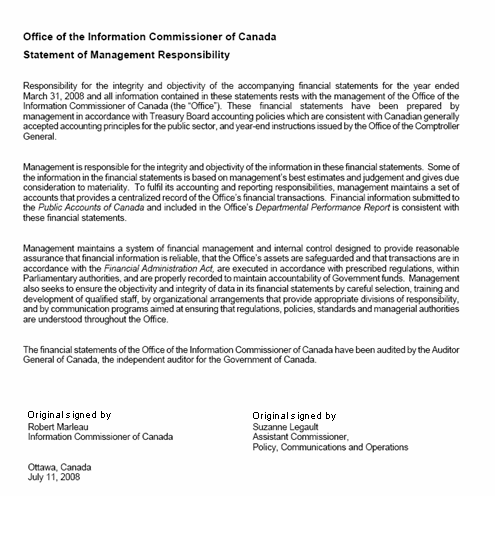
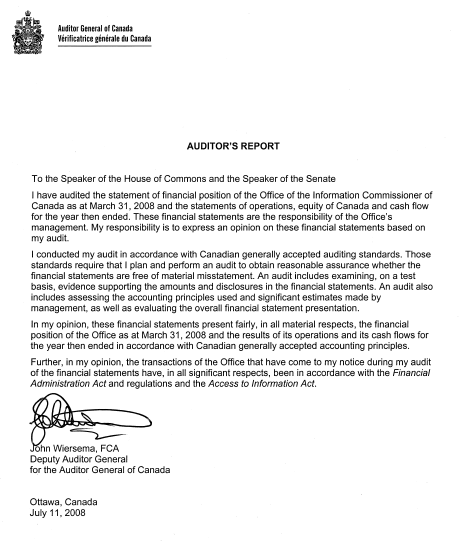
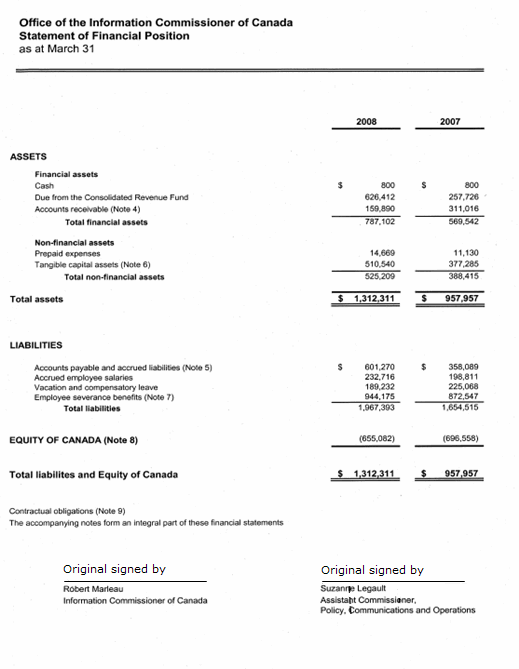
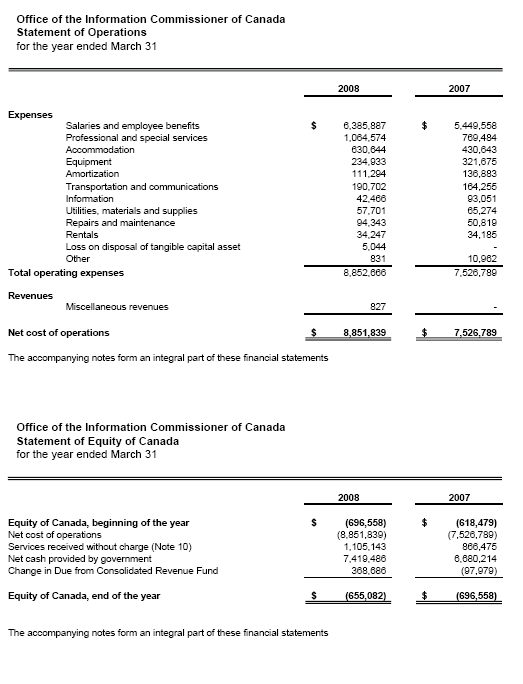
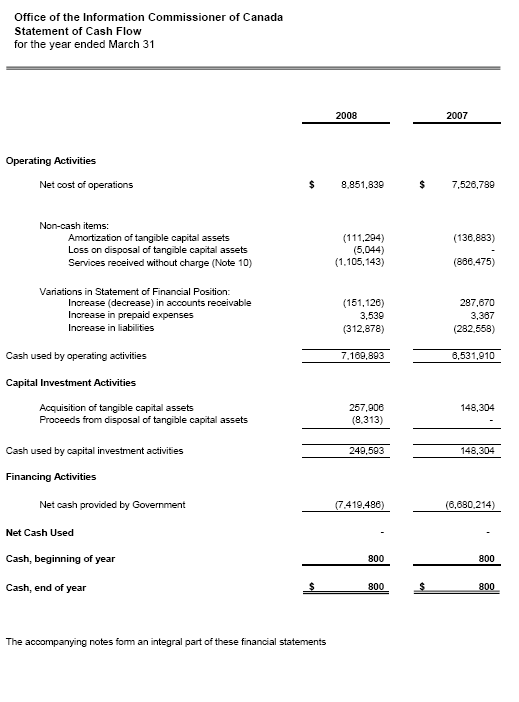
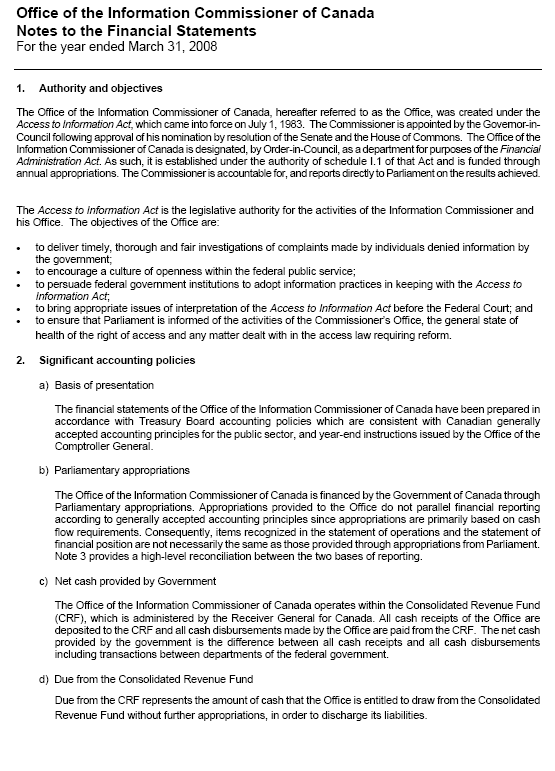
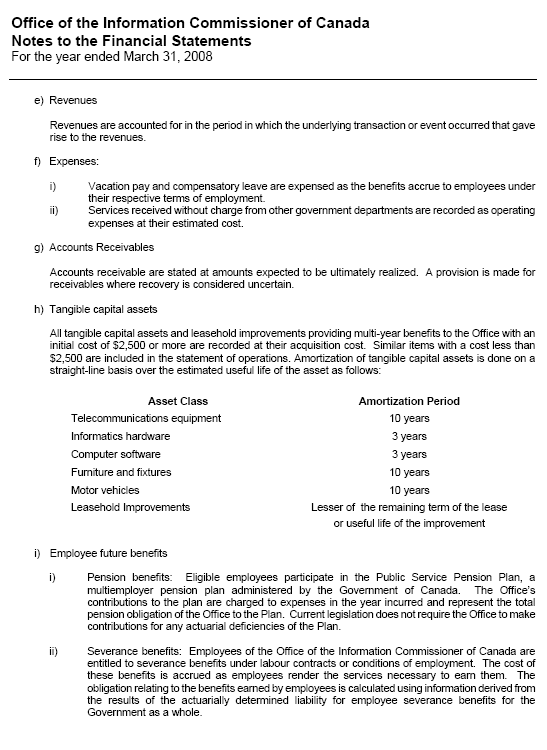
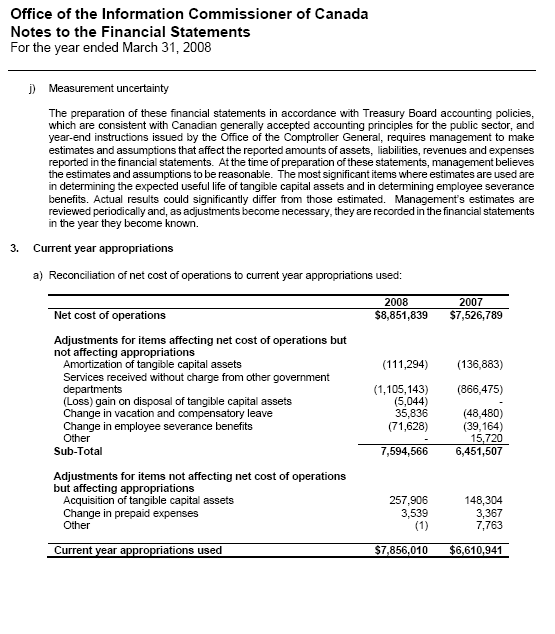
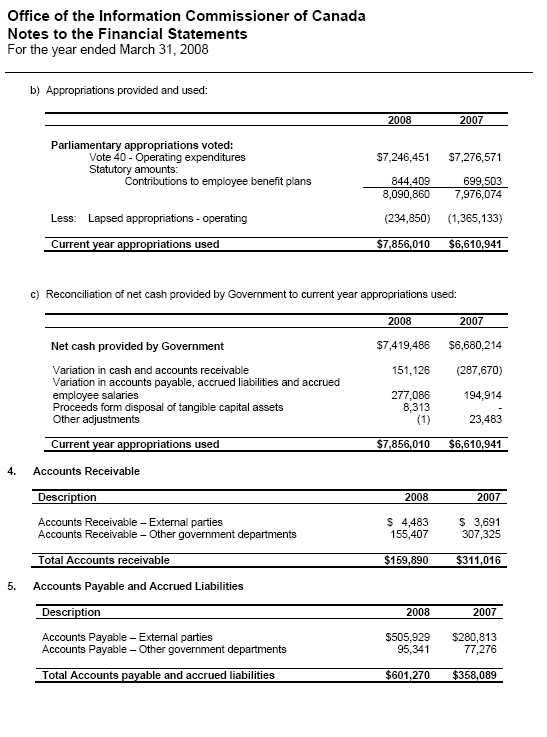
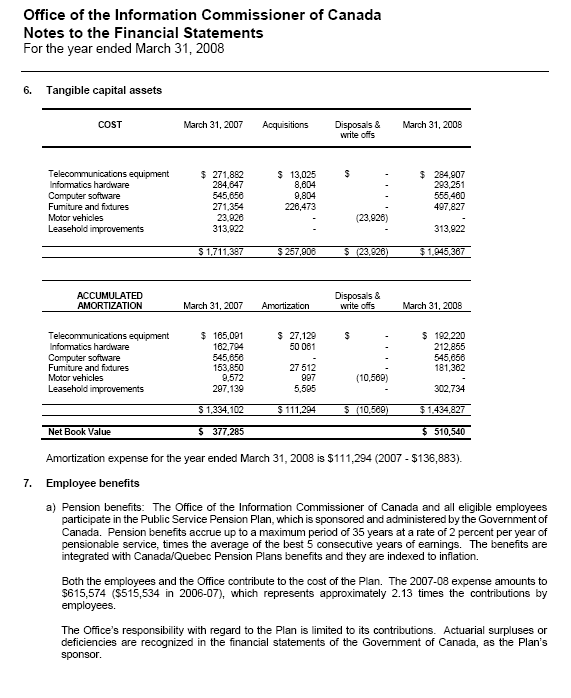
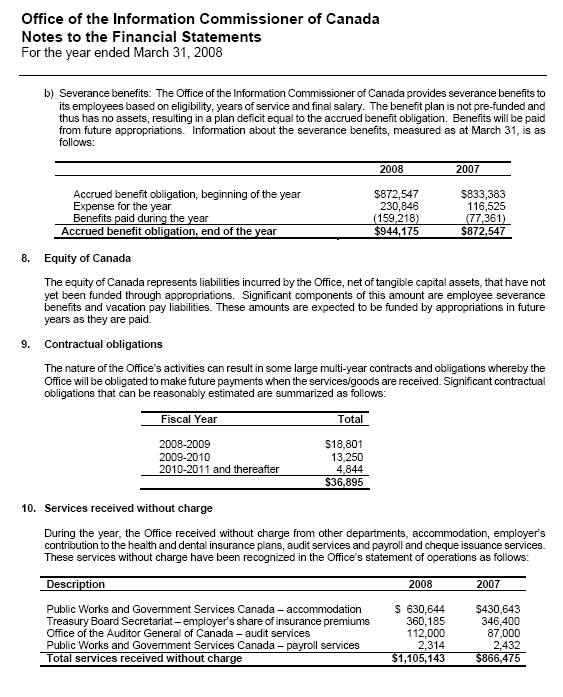
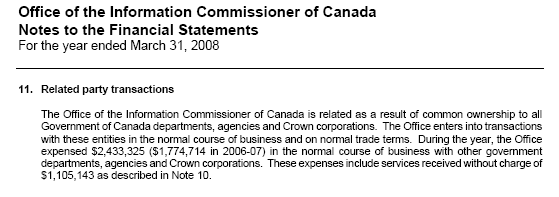
3.3 Sources of Additional Information
Legislation Administered by the Information Commissioner
Access to Information Act R.S.C. 1985, ch. A-1, amended 1997, c.23, s. 21.
Statutory Annual Reports and Other Publications
Statutory reports, publications and other information are available from the Office of the Information Commissioner of Canada, Ottawa, Canada K1A 1H3; tel.: (613) 995-2410 and on the OIC's Web site at www.infocom.gc.ca.
Contact for Further Information
Josée Villeneuve
Director of Strategic Planning, Parliamentary Relations and Communications
Office of the Information Commissioner of Canada
Place de Ville, Tower B
112, Kent Street, 7th Floor
Ottawa, Ontario K1A 1H3
Telephone: (613) 947-2223
Facsimile: (613) 995-1501
Section IV: Other Items of Interest
This Section describes the management achievements and reports on the administration of the Act in 2007-2008, both of which have contributed directly to the achievement of one of the four priorities that the Office had set for this fiscal year. More detail about the following priority is reported in Section 1.6 of this Report.
| Priorities | Type |
| Establish and administer a capacity to respond to requests under both the Access to Information Act and the Privacy Act, and comply with administrative provisions of those statutes. | New |
4.1 Management Achievements
Management activities serve to effectively support the delivery of Program Activity 1. They include: management control and accountability (covering finance, internal audit and evaluation), human resources, information management and technology, communications, and administrative services. Resources associated with internal services have been incorporated to the Program Activity they support. This section presents the management achievements for 2007-2008.
Management Control and Accountability
The Office sought and received additional funds to comply with the requirements of the Access to Information Act as amended by the Federal Accountability Act, as well as to establish and maintain an internal audit function. The Office also received funding to undertake a review of operations and funding levels (A-base review) to determine whether current levels may adversely impact the ability of the Office to deliver on the legislative mandate and put the integrity of the program at risk. The A-base review will be undertaken in 2008-2009.
Human Resources
As a result of the restructuring of the Office in 2007-2008, a new Human Resources team consisting of additional resources was created. The HR team was responsible for the development of a new sub-delegation authorities instrument, a new Integrated Human Resources Plan aligned with the organizational business planning process and the continued work on the development of the Office staffing monitoring framework.
Other activities and initiatives undertaken this year by the HR team were the on-going revision of all human resources policies as well as the introduction of new policies such as a Formal Recognition Award Program, Performance and Learning Agreements for all employees. In addition, two new human resources committees were established: a Labour-Management Consultation Committee and a Health and Safety Committee.
Information Management / Information Technology (IM/IT)
In 2007-2008, the Office built a computer network infrastructure including construction of a new local area network (LAN) room. The construction involved building a larger LAN room to accommodate more server equipments. As part of this improvement, we also created an internal computer help desk position.
Internal Audit
As indicated above, the Office obtained funds to establish an internal audit function that complies with the Treasury Board Secretariat’s policy and directives while preserving the Office’s independence from government. The function will be established, including the appointment of a chief audit executive, the development of a risk-based internal audit plan, and the establishment of an independent audit committee, by April 1st, 2009.
Administration
During 2007-2008, the Office partly resolved the accommodation problem by obtaining additional office space. A move took place at the beginning of 2008-2009.
4.2 Reporting on the administration of the Access to Information Act
The Office became subject to the Access to Information Act and the Privacy Act on April 1, 2007. In 2007-2008, the Office set up a secretariat – essentially an access to information and privacy office – in the Office's Information Management Division to administer both Acts. The work of the secretariat involves responding to requests under both Acts, as well as to requests from other institutions considering releasing information generated by the Office (called consultations).
In 2007-2008, we received 93 access requests and 3 privacy requests. We participated in 21 consultations.
The Office secured funding for permanent staffing of the secretariat and to purchase software to support the processing of access and privacy requests. The software will also help the Office to comply with the reporting requirements set out in Treasury Board's policies on access to information and privacy protection, as well as produce the annual reports on administration of the Acts that we will present to Parliament each year.
Complaints
The amendments to the Access to Information Act stemming from the Federal Accountability Act that made the Office subject to the Act did not set out how access to information complaints against the Office would be handled. To ensure that there are proper safeguards in place to prevent the conflict of interest that would arise if we had to investigate ourselves, the Commissioner appointed an ad hoc Commissioner to handle these investigations. The Former Supreme Court of Canada Justice, Honourable Peter de C. Cory agreed to take up this new office establishing guiding principles for it and how it would operate.
In 2007-2008, the Office was notified of 10 access to information complaints. Seven complaints were completed during the year: 4 were not substantiated; 2 were cancelled; 1 was resolved.
1 The Office added a rating “partially met” to the Treasury Board Secretariat’s scale that was restricted to the following ratings: successfully met, not met, or exceeded expectations. A commitment that is partially met indicates that some elements were achieved as planned and other elements were either not achieved or
delayed.
2 The Office selected the following ten (10) institutions: Canada Border Services Agency; Department of Foreign Affairs and International Trade; Department of Justice Canada; Department of National Defence; Health Canada; Library and Archives Canada; Natural Resources Canada; Privy Council Office; Public Works and Government Services Canada; and
Royal Canadian Mounted Police.
3 Canada (Attorney General) v. Canada (Information Commissioner) 2007 FC 1024 (T-531-06).
4 Canada (Minister of Industry) v. Canada (Information Commissioner), 2007 FCA 212 (A-107-06).
5 Canada (Minister of Environment) v. Canada (Information Commissioner), 2007 FCA 404 (A-502-06).
6 SNC Lavalin Inc. v. Canada (Minister for International Cooperation), 2007 FCA 397.
7 Privacy Commissioner of Canada v. Blood Tribe, S-31755. The decision was issued on July 17, 2008.